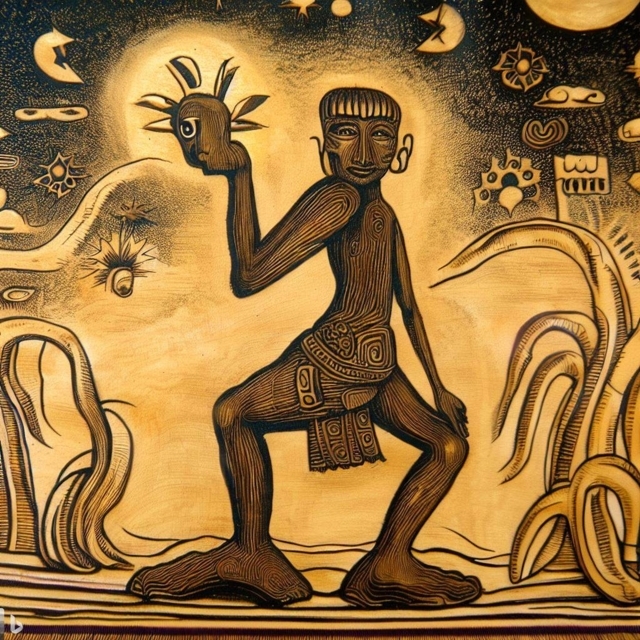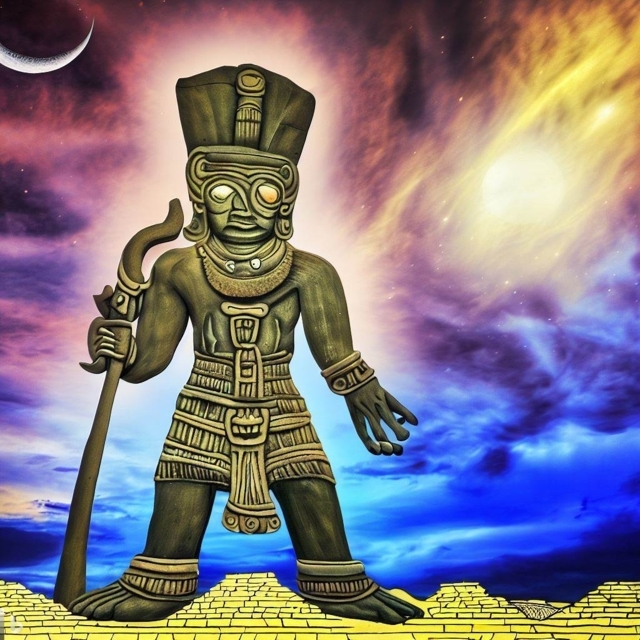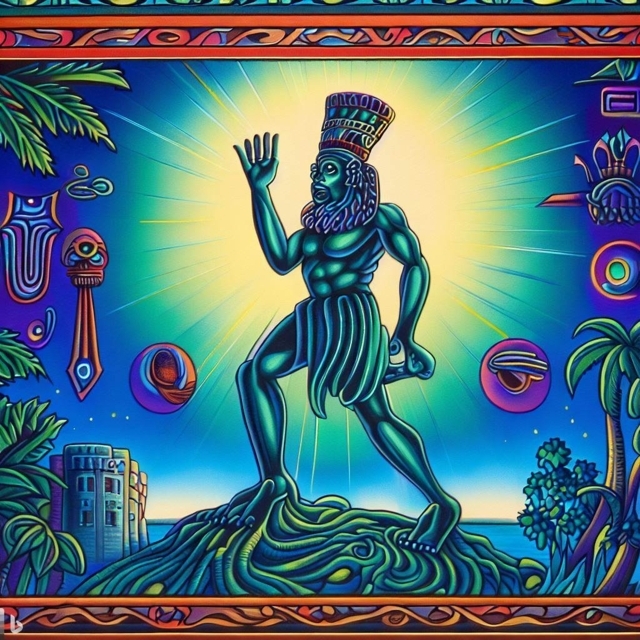The First Man and Bringer of Civilization in Kuba Kingdom Mythology.
The Kuba Kingdom was a conglomerate of several smaller principalities of various ethnic origins that existed between the 17th and 19th centuries in the region bordered by the Sankuru, Lulua, and Kasai rivers in the heart of the modern-day Democratic Republic of the Congo. The Kuba Kingdom was renowned for its artistic and cultural achievements, which were facilitated by political stability and the efficient use of natural resources. The Kuba Kingdom was a hierarchical complex of councils and titled officials who advised the king and balanced his power. The Kuba people call themselves “the children of Woot” after their founding ancestor.
The Myth of Woot
According to Kuba Kingdom mythology, Woot was the first man and bringer of civilization. In the Kuba Kingdom creation story, Woot stole a basket from the creator god Mbwoom but then lost it. The basket was later found by a Pygmy, who gave it to the Kuba people. Woot is also said to have named each human, plant, and animal.
The Role of Woot in Kuba Kingdom Culture
Woot played a significant role in Kuba Kingdom culture. He was revered as a hero and praised as “God on Earth”. The Kuba kings were at the center of artistic innovation, and they commissioned local artisans to produce elegant items for display. Objects such as embroidered textiles, fiber and beaded hats, and wooden cups and containers became increasingly ornate and fanciful. The Kuba people also created masks and sculptures that represented Woot and his wife/sister, Nady Amwaash.
Kuba Kingdom Art and Woot
The Kuba Kingdom’s artistic achievements were facilitated by political stability and the efficient use of natural resources. The Kuba people were renowned for the refinement of decorative art objects created for members of the high ranks of their society. The Kuba people created masks and sculptures that represented Woot and his wife/sister, Nady Amwaash. The Ngady Mwaash mask represents the wife of Woot, who is also his sister. The Kuba people also created textiles made from vegetal fibers, bark, palm tree leaves, and raffia.
Conclusion
Woot played a significant role in Kuba Kingdom culture and mythology. He was revered as a hero and praised as “God on Earth.” The Kuba Kingdom’s artistic achievements were facilitated by political stability and the efficient use of natural resources. The Kuba people created masks, sculptures, and textiles that represented Woot and his wife/sister, Nady Amwaash. The Kuba Kingdom’s cultural and artistic achievements continue to inspire and fascinate people today.
References
– The Metropolitan Museum of Art. “Kingdoms of the Savanna: The Kuba Kingdom.” Heilbrunn Timeline of Art History. https://www.metmuseum.org/toah/hd/kuba/hd_kuba.html
– WikiSummaries. “Formation of the Kuba Kingdom Summary.” https://wikisummaries.org/formation-of-the-kuba-kingdom/
– Rand African Art. “Kuba.” https://www.randafricanart.com/kuba_Ngady_aMwaash.html
– Scholars at Harvard. “The Evolution of Culture and Institutions: Evidence from the Kuba Kingdom.” https://scholar.harvard.edu/files/nunn/files/kuba_paper_september_2016.pdf
– AfricaOTR. “Artistic Kuba Kingdom Under King Kot Mabiinc.” https://africaotr.com/artistic-kuba-kingdom-under-king-kot-mabiinc/
– Wikipedia. “Kuba Kingdom.” https://en.wikipedia.org/wiki/Kuba_Kingdom
– Think Africa. “The Kuba Kingdom.” https://thinkafrica.net/kubakingdom/
– Africa Online Museum. “DR Congo » Kuba Kingdom » Photos.” https://africaonlinemuseum.org/map/dr-congo/kuba-kingdom/photos/
– JSTOR. “THE EVOLUTION OF CULTURE AND INSTITUTIONS: EVIDENCE FROM THE KUBA KINGDOM.” https://www.jstor.org/stable/44955153
– Pinterest. “TEXT-MODE — Made in the Kuba Kingdom in Africa.” https://www.pinterest.com/pin/textmode-made-in-the-kuba-kingdom-in-africa-they-are–331788697561326433/
– BellaOnline. “Story of Creation by the Kuba People – African Culture.” http://www.bellaonline.com/articles/art16319.asp
– Scholars at Harvard. “The Evolution of Culture and Institutions: Evidence from the Kuba Kingdom.” https://scholar.harvard.edu/files/jonathanweigel/files/kuba_paper_nov16_2015.pdf
– African Arts Gallery. “African art Kuba, art items of the Kuba ethny.” https://www.african-arts-gallery.com/african-art/ethnie-Kuba
– Kumakonda. “The Kuba Kingdom of Congo and its fantastic past.” https://kumakonda.com/kingdom-kuba-of-the-congo-history-and-art/
– Fulton County Schools. “THE KUBA KINGDOM & THE DRC.” https://www.fultonschools.org/cms/lib/GA50000114/Centricity/domain/273/fcs%20archives/feb%202022%20-%20history.pdf
– Oxford Reference. “Woot Takes Language from the Fly, the Tortoise, and the Dog.” https://www.oxfordreference.com/view/10.1093/oi/authority.20110803124717841
– Amazon. “The Children of Woot: A History of the Kuba Peoples.” https://www.amazon.com/Children-Woot-History-Kuba-Peoples/dp/0299074900
– https://umfa.utah.edu/kuba-masks
– https://theafricanhistory.com/2926
Tags
Divi Meetup 2019, San Francisco
Related Articles
Unappreciated Greatness
Life and Legacy of Jahangir of the Mughal Empire. Jahangir ruled over one of the largest empires in human history during his lifetime, yet few people outside of South Asia have heard of him. I aim to shed light on the life and legacy of this remarkable figure,...
The Plague Doctor’s Diary
A Personal Account of the Turin Epidemic of 1656. I am writing this diary to record my experiences and observations as a plague doctor in Turin, the capital of the Duchy of Savoy, during the terrible epidemic that has afflicted this city and its surroundings since the...
The Timeless Beauty of Bustan
Unveiling the Secrets of Saadi Shirazi's Masterpiece.In the realm of Persian literature, few works have captured the essence of love, spirituality, and morality quite like Bustan (The Orchard) by Saadi Shirazi. This 13th-century masterpiece has left a lasting impact...
Stay Up to Date With The Latest News & Updates
Explore
Browse your topics of interest using our keyword list.
Join Our Newsletter
Sign-up to get an overview of our recent articles handpicked by our editors.
Follow Us
Follow our social media accounts to get instant notifications about our newly published articles.









